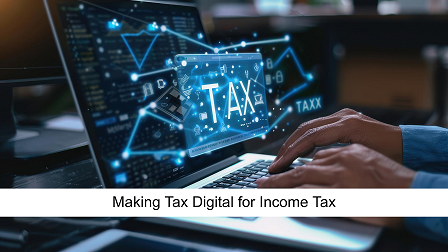
Doing your taxes can feel confusing and stressful. But soon, there will be a big change. Making Tax Digital for Income Tax is a new system to help people, such as the self-employed, landlords, and small business owners, manage their tax records online. It will officially start from 6 April 2026.
With this new system, instead of keeping lots of paperwork and sending one big tax return each year, you will keep digital records and send updates to HMRC regularly, usually every three months. This new way will make tax time easier, quicker, and less stressful.
It will also help reduce mistakes and make sure you pay the right amount of tax. In this blog, we will explain what Making Tax Digital means, why it is happening, and how you can prepare for these changes to make things smoother for you.
Making tax digital for income tax is a new government plan. The goal is to move tax record-keeping and submissions online. HMRC believes this will make the tax system more efficient, reduce errors, and make life easier for taxpayers.
Instead of annual paper tax returns, you’ll need to keep digital records and send tax updates online. This applies if you have self-employment or property income.
Making Tax Digital for Income Tax Self-Assessment (MTD for ITSA) is being rolled out gradually based on income thresholds.
If your income is below £20,000, you won’t need to follow the new rules yet. But you can choose to do so if you wish.
Benefited for:
The government wants to simplify tax reporting. Many people make mistakes or misplace receipts. Keeping everything digital should help cut out errors and big, stressful surprises at tax time.
Other reasons include:
Under Making Tax Digital for Income Tax, you’ll need to change how you keep records and report to HMRC. Here’s what’s required:
Step 1: Work out your income:
Add up your self-employment and property income. If it’s more than £50,000, you must follow Making Tax Digital for income tax from April 2026.
Step 2: Sign up for an online account:
If you haven’t already, open or update your tax account with HMRC.
Step 3: Choose your software:
Find a digital tool suitable for you. Best options include Nomi, Xero, QuickBooks, FreeAgent, and others.
Step 4: Start keeping digital records:
Scan or photograph receipts. Record all sales and expenses in your software.
Step 5: Send quarterly reports:
Your software should do most of the work. Check details and submit each quarter.
Step 6: Final declaration:
Once a year, confirm everything is right. Add in any extra income, such as bank interest.
This does not mean you have to scan every receipt; typing details into your app is fine, as long as records are kept up-to-date.
Making Tax Digital (MTD) for Income Tax offers several benefits that can make managing your taxes easier and more efficient:
From April 2026, Making Tax Digital for Income Tax Self Assessment (MTD for ITSA) will be mandatory for most self-employed individuals and landlords earning over £50,000. If you want help preparing for this change, PHS Associates can guide you through every step of Making Tax Digital, whether you're a sole trader, landlord, or submitting a Self Assessment tax return. Contact us at 0208 8611685 or email info@phs-uk.co.uk.